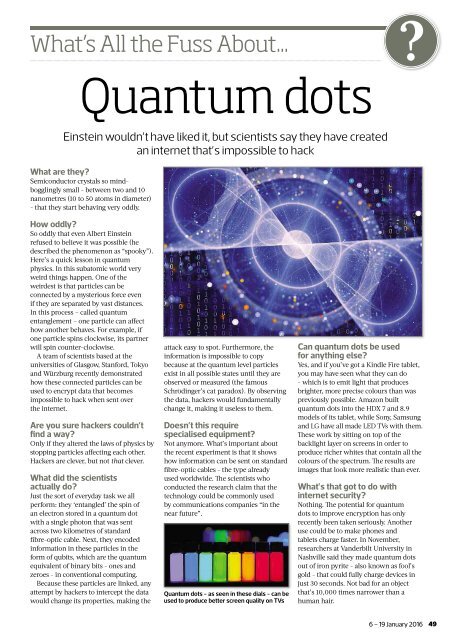Create successful ePaper yourself
Turn your PDF publications into a flip-book with our unique Google optimized e-Paper software.
What’s All the Fuss About...<br />
Quantum dots<br />
Einstein wouldn’t have liked it, but scientists say they have created<br />
an internet that’s impossible to hack<br />
What are they?<br />
Semiconductor crystals so mindbogglingly<br />
small - between two and 10<br />
nanometres (10 to 50 atoms in diameter)<br />
- that they start behaving very oddly.<br />
How oddly?<br />
So oddly that even Albert Einstein<br />
refused to believe it was possible (he<br />
described the phenomenon as “spooky”).<br />
Here’s a quick lesson in quantum<br />
physics. In this subatomic world very<br />
weird things happen. One of the<br />
weirdest is that particles can be<br />
connected by a mysterious force even<br />
if they are separated by vast distances.<br />
In this process <strong>–</strong> called quantum<br />
entanglement <strong>–</strong> one particle can affect<br />
how another behaves. For example, if<br />
one particle spins clockwise, its partner<br />
will spin counter-clockwise.<br />
A team of scientists based at the<br />
universities of Glasgow, Stanford, Tokyo<br />
and Würzburg recently demonstrated<br />
how these connected particles can be<br />
used to encrypt data that becomes<br />
impossible to hack when sent over<br />
the internet.<br />
Are you sure hackers couldn’t<br />
fi nd a way?<br />
Only if they altered the laws of physics by<br />
stopping particles affecting each other.<br />
Hackers are clever, but not that clever.<br />
What did the scientists<br />
actually do?<br />
Just the sort of everyday task we all<br />
perform: they ‘entangled’ the spin of<br />
an electron stored in a quantum dot<br />
with a single photon that was sent<br />
across two kilometres of standard<br />
fi bre-optic cable. Next, they encoded<br />
information in these particles in the<br />
form of qubits, which are the quantum<br />
equivalent of binary bits - ones and<br />
zeroes - in conventional computing.<br />
Because these particles are linked, any<br />
attempt by hackers to intercept the data<br />
would change its properties, making the<br />
Caption<br />
attack easy to spot. Furthermore, the<br />
information is impossible to copy<br />
because at the quantum level particles<br />
exist in all possible states until they are<br />
observed or measured (the famous<br />
Schrödinger’s cat paradox). By observing<br />
the data, hackers would fundamentally<br />
change it, making it useless to them.<br />
Doesn’t this require<br />
specialised equipment?<br />
Not anymore. What’s important about<br />
the recent experiment is that it shows<br />
how information can be sent on standard<br />
fi bre-optic cables - the type already<br />
used worldwide. Th e scientists who<br />
conducted the research claim that the<br />
technology could be commonly used<br />
by communications companies “in the<br />
near future”.<br />
Quantum dots - as seen in these dials - can be<br />
used to produce better screen quality on TVs<br />
Can quantum dots be used<br />
for anything else?<br />
Yes, and if you’ve got a Kindle Fire tablet,<br />
you may have seen what they can do<br />
- which is to emit light that produces<br />
brighter, more precise colours than was<br />
previously possible. Amazon built<br />
quantum dots into the HDX 7 and 8.9<br />
models of its tablet, while Sony, Samsung<br />
and LG have all made LED TVs with them.<br />
Th ese work by sitting on top of the<br />
backlight layer on screens in order to<br />
produce richer whites that contain all the<br />
colours of the spectrum. Th e results are<br />
images that look more realistic than ever.<br />
What’s that got to do with<br />
internet security?<br />
Nothing. Th e potential for quantum<br />
dots to improve encryption has only<br />
recently been taken seriously. Another<br />
use could be to make phones and<br />
tablets charge faster. In November,<br />
researchers at Vanderbilt University in<br />
Nashville said they made quantum dots<br />
out of iron pyrite - also known as fool’s<br />
gold - that could fully charge devices in<br />
just 30 seconds. Not bad for an object<br />
that’s 10,000 times narrower than a<br />
human hair.<br />
6 <strong>–</strong> 19 <strong>January</strong> <strong>2016</strong> 49







